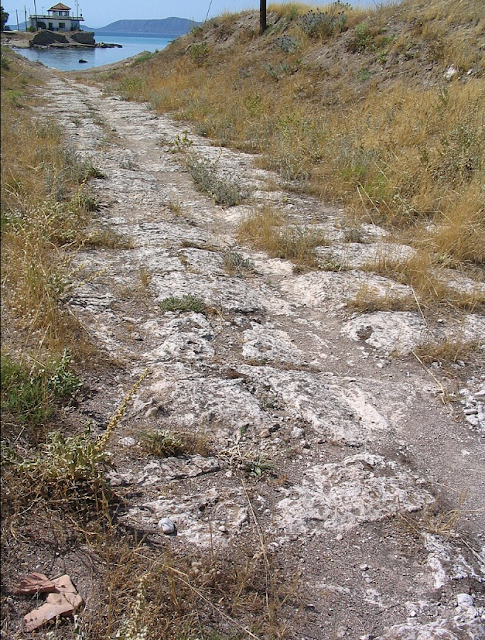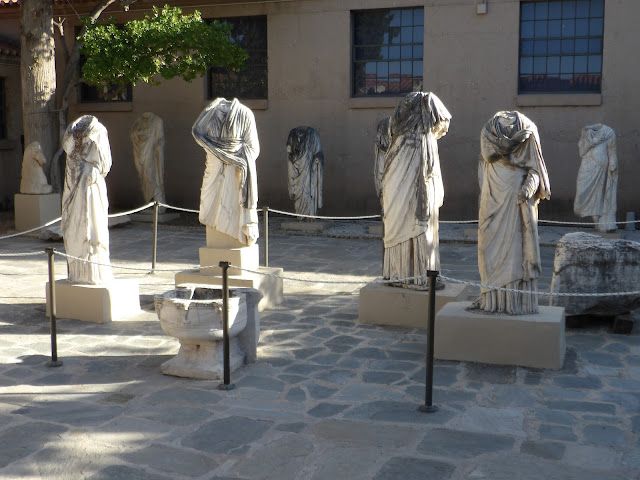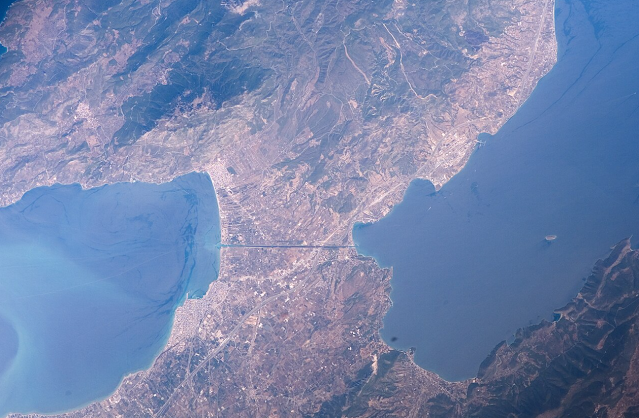Corinth was a city-state on the Isthmus of Corinth, the narrow stretch of land that joins the Peloponnese to the mainland of Greece, roughly halfway between Athens and Sparta. The modern city of Corinth is located approximately 3.1 miles northeast of the ancient ruins. Since 1896, systematic archaeological investigations of the Corinth Excavations by the American School of Classical Studies at Athens have revealed large parts of the ancient city, and recent excavations conducted by the Greek Ministry of Culture have brought to light important new facets of antiquity.
For Christians, Corinth is well known from the two letters of Saint Paul in the New Testament, First and Second Corinthians. Corinth is also mentioned in the Acts of the Apostles as part of Paul the Apostle's missionary travels. In addition, the second book of Pausanias' Description of Greece is devoted to Corinth.
Ancient Corinth was one of the largest and most important cities of Greece, with a population of 90,000 in 400 BC. The Romans demolished Corinth in 146 BC, built a new city in its place in 44 BC, and later made it the provincial capital of Greece.
Agora (marketplace)
Marble streets
 |
| High hill less than a kilometer away |
Brothel for sailors waiting for their boats to be hand pulled over the isthmus of Corinth (see below) prior to completion of a canal
Statues from various Corinthian places in the ancient city
Significance of Corinth in the Bible
Corinth was significant in the ancient Roman world because of its geography, its wealth, and its regional influence. In the Bible, Corinth is significant because of its connection with the apostle Paul’s missionary work. Corinth was the capital of the Roman province of Achaia and was situated on the Isthmus of Corinth, and about 40 miles west of Athens in Greece. It was a large city that controlled two harbors: Cenchreae on the eastern side of the isthmus, and Lechaeumon on the western side. Providing a natural refuge for the city was the Acrocorinthus, a large monolithic rock rising about 1,800 feet above the surrounding plain. Corinth had a large population of both Jewish and Gentile residents.
Paul spent about eighteen months in Corinth during his
second missionary journey (
Acts 18). Both Jews and Gentiles believed Paul’s message about Jesus, and these new believers became the
Corinthian church. The New Testament epistles of 1 and 2 Corinthians are letters Paul later wrote to these believers. Notably, Corinth is also the place where Paul met Aquila and Priscilla, fellow tentmakers who became ministry coworkers (
Acts 18:2,
18–19,
24–28).
Paul first traveled to Corinth after spending time preaching in Athens (see
Acts 17:16—18:1). Upon arriving in Corinth, Paul met
Aquila and Priscilla, who were tentmakers like the apostle, so Paul lived and worked with them (
Acts 18:2–3). As was his custom, Paul reasoned in the Jewish synagogue every Sabbath, sharing the truth about Jesus, for as long as the Jews and God-following Gentiles there would endure it (
Acts 18:4–5). When opposition and abuse arose, Paul took the message of the gospel more directly to the Gentiles (
Acts 18:6). Utilizing the house of Titius Justus, a Gentile who worshiped God and lived next door to the synagogue, Paul continued to share the message of the gospel. Many Corinthians placed their faith in Christ, including the synagogue ruler and his family (
Acts 18:7–8).
In Corinth the Lord spoke to Paul in a vision, telling him not to fear but to keep speaking. God promised, “For I am with you, and no one is going to attack and harm you, because I have many people in this city” (
Acts 18:10). Paul stayed in Corinth for a year and a half, teaching the word of God and successfully establishing a group of believers there. Paul returned to visit the Corinthians at least twice (
2 Corinthians 13:1). He also wrote them several letters to address problems in the church. Two of those letters are in our Bibles today, known as 1 and 2 Corinthians. At least one letter Paul wrote to them before 1 Corinthians has been lost to history (see
1 Corinthians 5:9), and there was possibly another letter he wrote between 1 Corinthians and 2 Corinthians (see
2 Corinthians 7:8). We have in our Bibles the words that God intended for us. These other letters were important for the church at Corinth in that time, but are evidently not necessary for us today.
In
1 and
2 Corinthians, Paul addresses multiple issues. These range from division in the church, to immorality in the church, to freedom concerning foods, to voluntary restriction of rights, to spiritual gifts, to generosity, to explaining the glorious depth and beauty of the truth of the gospel, and more. Paul also defended his ministry in Corinth and his calling as an apostle because false teachers were leading the Corinthians astray. The words in these letters are theologically rich and of practical use in the church and our lives today.
First Corinthians addresses several issues of sexuality. There was a large following of the cult of Aphrodite among the Gentiles in Corinth—her temple was atop the Acrocorinthus, and her worship involved temple prostitution. In fact, the city had so many prostitutes that well-known Greeks, including Plato, openly referred to prostitutes as “Corinthians.” Although many natives of Corinth placed faith in Jesus, many were still influenced by their immoral surroundings, which promoted sexual immorality. In 1 Corinthians, Paul mentions the problem of sexual sin in the Corinthian church (
1 Corinthians 5:1–2). God ultimately used this problem to bring about Paul’s inspired writing on sexual purity, marriage, and singleness (
1 Corinthians 6—7). These inspired teachings have continued to instruct and guide the church regarding sexual issues. They are certainly beneficial to us in our sex-obsessed world.
Corinth was home to many people with diverse backgrounds, a characteristic reflected in the Corinthian church that contributed to some division and confusion. Previously legalistic Jews needed to hear about the freedom of the New Covenant in Christ; previously pagan Gentiles needed to be reminded that the gospel is not a license to sin. Both groups needed to learn to love the other and live at peace. Paul famously explains what true love is in
1 Corinthians 13. In our fractious world, this message of self-sacrificial love based in the person and work of Jesus Christ is equally important.
The city of Corinth was steeped in all the sins attendant upon a prosperous society, including idolatry and gross immorality, but the gospel still made a way through. We may fear our surrounding culture is too far away from God for people to hear His truth, but nothing is impossible for the Lord (
Luke 1:37;
Matthew 19:25–26). Paul gave the Corinthians a list of sinful behaviors that characterize those who will not enter God’s kingdom, then he declared, “And that is what some of you were. But you were washed, you were sanctified, you were justified in the name of the Lord Jesus Christ and by the Spirit of our God” (
1 Corinthians 6:11). God changes lives! In fact, “if anyone is in Christ, the new creation has come: The old has gone, the new is here! All this is from God, who reconciled us to himself through Christ and gave us the ministry of reconciliation” (
2 Corinthians 5:17–18). Just as Paul was an ambassador of Christ to the Corinthians, we can be His ambassadors in our world, imploring people “on Christ’s behalf: Be reconciled to God. God made him who had no sin to be sin for us, so that in him we might become the righteousness of God” (
2 Corinthians 5:20–21).


Prior to the 18th Century when the canal was finally cut and opened, slaves were used to pull boats over the Corinthian Isthmus by hand using wheeled carts. Ruts still remain.
The Corinth Canal is an artificial canal in Greece that connects the Gulf of Corinth in the Ionian Sea with the Saronic Gulf in the Aegean Sea. It cuts through the narrow Isthmus of Corinth and separates the Peloponnese from the Greek mainland, making the peninsula an island. The canal was dug through the Isthmus at sea level and has no locks. It is 4 miles in length and only 80.7 feet wide at sea level, making it impassable for many modern ships. It is currently of little economic importance and is mainly a tourist attraction.

The canal was initially proposed in classical times and a failed effort was made to build it in the 1st century AD. Construction recommenced in 1881 but was hampered by geological and financial problems that bankrupted the original builders. It was completed in 1893, but, due to the canal's narrowness, navigational problems, and periodic closures to repair landslides from its steep walls, it failed to attract the level of traffic expected by its operators.
https://en.wikipedia.org/wiki/Corinth_Canal
When this Bungy jumper dove headfirst off the platform, she was screaming within seconds. She was immediately out of sight; in less than a minute she bounced high enough to see her. This was repeated several times. Ah, to be young again! Haha.
Tomorrow we will bus into the Acropolis in Athens for our final day of touring. The subsequent day we will take air travel home, on three separate flights.





.png)


















Comments
Post a Comment